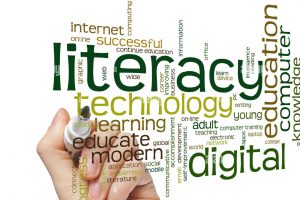In the digital age, both learners and educators must cultivate a diverse set of literacies to thrive in an increasingly interconnected and technology-driven world. By developing digital literacy, learners and educators can effectively navigate the complexities of the digital age, harnessing the power of technology to enhance learning, collaboration, and innovation while also fostering critical thinking, ethical responsibility, and global citizenship.

In light of the proposing a continuum of ‘Visitors’ and ‘Residents’ as an alternative framework for understanding digital engagement, I reflect on the digital literacy of a microbiology professor within this context. As an expert in a scientific field, the microbiology professor’s digital literacy is crucial not only for their personal use but also for their professional endeavors, including research, teaching, and collaboration.
The concept of ‘Visitors’ and ‘Residents’ offers a nuanced perspective on how individuals engage with technology, emphasizing motivation and context over categorical distinctions such as age or background. Applying this continuum to the microbiology professor’s digital literacy reveals a multifaceted approach to technology use.
In the realm of research, the professor may act as a ‘Resident,’ deeply immersed in online communities, utilizing various digital tools and platforms to access scientific literature, collaborate with colleagues worldwide, and disseminate their findings. This residency reflects a proactive and engaged stance towards technology, leveraging its potential to enhance scholarly pursuits.
Similarly, in teaching, the professor may transition between being a ‘Visitor’ and a ‘Resident,’ depending on the pedagogical context. As a ‘Visitor,’ they may utilize learning management systems and online resources as supplementary tools in the classroom. However, as a ‘Resident,’ they may adopt a more integrated approach, incorporating digital platforms for interactive teaching methods, facilitating online discussions, and providing virtual resources to enhance student learning experiences.
Moreover, the microbiology professor’s digital literacy extends beyond their professional roles into their personal life, where they may navigate social media platforms, online communities, and digital communication channels. Here, they may exhibit characteristics of both ‘Visitors’ and ‘Residents,’ engaging with technology for social interaction, information consumption, and leisure activities.
In our PBL6 group we focused on Changes in digital literacies in academia (pre-pandemic vs. post-pandemic). In summary, while the pandemic accelerated the adoption of digital technologies and transformed academic practices, the core principles of digital literacies in academia remained rooted in leveraging technology to enhance scholarly pursuits and professional development.
Overall, the continuum of ‘Visitors’ and ‘Residents’ offers a valuable framework for understanding the digital literacy of the professor and/or researcher, highlighting the dynamic and context-dependent nature of their engagement with technology. By recognizing the diverse ways in which individuals navigate the digital landscape, educators and researchers can tailor strategies to enhance digital literacy skills and effectively harness the potential of technology in academia and beyond.
Reference
Developing digital literacies (2014) JISC guide.
Deschenes, Andree-Anne (2024) Digital literacy, the use of collaborative technologies, and perceived social proximity in a hybrid work environment: Technology as a social binder. Computers in Human Behavior Reports, 13: 100351.
March 11, 2024 at 7:44 am
I agree with your views related to the visitor-residence framework. It’s good to recognize the different contexts and purposes where we use digital tools and to develop strategies for use in order to remain safe while being “out there”.
March 11, 2024 at 8:01 am
Thank you for your comment, Diane.
March 14, 2024 at 11:41 am
Indeed, it is useful to have a framework for conceptualising digital engagement, but I think the emphasis here really needs to be on the continuum aspect and that there is not a black and white (always resident or always visitor). As you said, we are constantly switching roles between resident and visitor and it heavily depends on the context in which we use digital tools. And being aware of this constant change of roles helps to understand how we use these tools in a safe and efficient manner. So, yes, I fully agree with your reflections and I think these are not necessarily be tied to the microbiology professor context but rather general for the academic context.